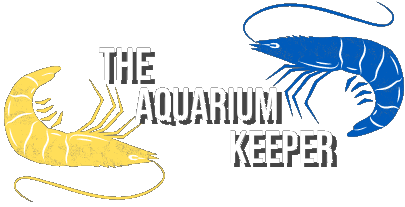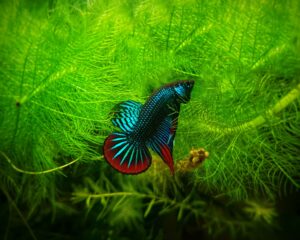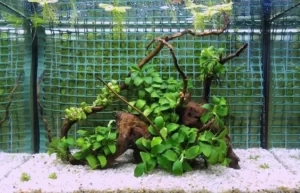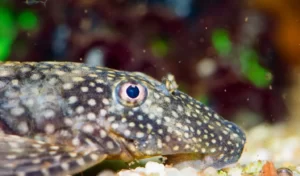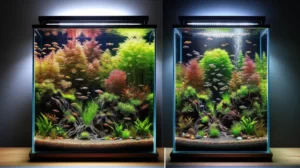
Caridina Shrimp Care: Tank Requirements, Breeding & More

Writer at The Aquarium Keeper
Caridina shrimp are a species from the Atyidae family that are popular amongst fish keepers for uncountable reasons! Having a shrimp tank is surely one of the best experiences in this hobby.. Still, understandably, not everyone is familiar with how to care for them. This can be because caridina shrimp are not as widespread as other common fish species such as bettas, goldfish, and guppy fish. Nevertheless, this article will take you through almost everything you need to know to provide a healthy and thriving aquatic environment for your caridina shrimp.
Caridina Shrimp Origin
The caridina shrimp is native to the freshwater streams of Asia, particularly in countries like Taiwan and Indonesia. Most caridina shrimp sold at pet shops are captive bred as it is easier and more convenient than sourcing from the wild. Due to their growing popularity, fish breeders engage in breeding caridina shrimp on a large scale, and are later distributed to meet the demand of aquarists.
Captive-bred caridina shrimp are also more unique-looking since breeders learned how to preserve a certain coloration or pattern of the caridina shrimp. More and more new caridina shrimp variations appear on the market, and some can be expensive in thousands of dollars.
Caridina Shrimp Types And Appearance
The exact appearance of caridina shrimp is not universal, since every single species have a different color, some sort of pattern, and something, that makes them unique. The most popular caridina shrimp are red crystal shrimp, amano shrimp, bee shrimp, and sulawesi shrimp.
There are a lot of different types of caridina shrimp, and each and everyone deserves a separate article. Most caridina shrimp species are 1-1.5 inches in size, although some larger caridina shrimp like the amano shrimp can reach up to 2.5 inches in length.

Here is a list of all my found caridina shrimp types:
- Zebra Shrimp
- Blue Bolt Shrimp
- Crystal Red Shrimp
- Metallic Blue Boa Shrimp
- Golden Crystal Shrimp
- Black Crystal Shrimp
- Orange Eye Shrimp
- Black Fancy Tiger Shrimp
- Red Galaxy Shrimp
- Red Fancy Tiger Shrimp
- Taiwan Bee Shrimp
- King Kong shrimp
- Shadow Panda Shrimp
- Sulawesi Shrimp
Some of these species are rarer than others. The most basic types like crystal red shrimp can be available for as less as 5$, while more fancy species like shadow panda shrimp cost at least 60$ per shrimp.
You might also like to read: 20 Common and Rare Neocaridina Shrimp Colors
Caridina Shrimp Life Expectancy
Caridina shrimp can live up to 1-2 years. These creatures can live longer (usually around 2 years) when provided with good care. However, aquarists can expect their shrimp to live around 14-18 months, which is their standard lifespan when kept in an aquarium.
Maintaining good water quality and feeding them a healthy diet is vital to ensure they live long and healthy lives. All such factors to help your caridina shrimp live longer will be discussed later in this article!
Caridina Shrimp Temperament & Behaviour
Moving on, caridina shrimp are peaceful creatures that do not show any signs of aggression. They do not bite or chase other fish, making them perfect for community tanks with species of similar temperament. However, there are instances where caridina shrimp may scavenge on the bodies of dead fish. Other than that, they are entirely safe to be housed with other tank mates.
These creatures occupy the lower column of the aquarium and would love to explore the decorations and fittings within the tank. Like any other type of shrimp, the caridina shrimp is a slow mover, meaning they do not swiftly move across their tank. Caridina shrimp only have the ability to dash backwards with their tail, if they feel threatened. Furthermore, caridina shrimp do not often hide unless stressed or newly introduced to their tank. Therefore, if you notice your caridina shrimp being shy or away for a long time, it is likely that they are stressed, so ensure to investigate the probable cause for it!
Caridina Shrimp Water Conditions
There can be slight differences in the water conditions required for various caridina shrimp varieties, but there are some parameters that can be followed in general. These species thrive in the water temperature range between 20–24 °C (68–75 °F). When it comes to pH, most caridina shrimp need acidic water to thrive (apart from amano shrimp). The pH level should always be between 6.0-7.0. Because of the water parameter requirements, most aquatic shops don’t recommend caridina shrimp to beginners, because it is sometimes not easy to ensure stable parameters at all times.
Caridina shrimp need lower pH because they won’t be able to molt (break out of their old exoskeleton) if the water conditions are not right. There are a couple of ways to ensure the right levels of pH:
- Use special shrimp soil, that lowers the pH level;
- Use reverse osmosis (RO) or distilled water for your shrimp tank;
- Use caridina shrimp mineral supplements for your shrimp tank to ensure the right parameters;
In most cases, at least two methods are needed to ensure the right water parameters. Keeping the pH low is very important because the little lives of caridina shrimp depend on it.
Caridina Shrimp Tank Setup
When choosing a tank for your caridina shrimp, it is recommended to select a tank of at least 5 gallons. A common mistake certain aquarists make is that they house caridina shrimp in tiny aquariums such as 1-gallon tanks, which cram the shrimp. Certain pet shops may advise novice aquarists to house caridina shrimp in such small tanks, but this is not recommended! Although they are dwarf shrimps, they still require some space to move around. Accommodating them in smaller tanks is possible, but they would not thrive, resulting in them feeling stressed, which will shorten their lifespan.

To provide a healthy aquatic environment for your caridina shrimp, you can replicate their natural habitat within the aquarium. This can be done by adding ample natural plants, rocks, and wood branches. There are a lot of good plants for shrimp tanks, that are beginner friendly. Caridina shrimp enjoy exploring surfaces, making it wise to decorate using them. Moreover, caridina shrimp can live in both lighted and dark aquariums. However, it is recommended to provide sufficient lighting along with some dark spots for them to thrive. It is not essential to keep the aquarium lights switched on for the entire day, instead, it is recommended to switch them off at night when not needed.

If your aquarium has adequate live plants, having an air pump would not be necessary. However, if you wish to add a lot of caridina shrimp, setting an aerator to create bubbles will be beneficial. Moreover, installing a filter is suggested, as it will help circulate clean water. If a filter is not present, you must conduct tank maintenance more often, as good water quality is essential for caridina shrimp. When choosing a filter for these creatures, it is suggested to pick a sponge filter or a corner filter, as they do not create harsh water movement. Caridina shrimp thrive in calm waters, similar to their natural habitat. Due to this, it is recommended to choose a filter with an adjustable or gentle flow rate.
Caridina Shrimp Diet
All caridina shrimp are omnivorous, meaning they consume food from both plant and animal matter. Generally, feeding caridina shrimp is easy, as they consume almost anything provided to them. Also, do not forget the fact that they have an enormous appetite, which makes it essential to feed these tiny creatures timely!
When talking about their diet, it is recommended to feed them 3-4 times per week, depending on the supply of food present in their tank. If algae grows in your tank, you will not need to feed them much often. However, algae should not be the only component in their diet, so ensure to feed them with various food. Some types of food you can provide are lettuce, blanched spinach, bloodworms, and store-bought shrimp flakes/ pellets. Providing caridina shrimp with a protein-rich diet is essential, so ensure to feed them occasionally with food such as bloodworms.
You might also like to read: Do Shrimp Eat Fish Poop? The Simple Truth
Caridina Shrimp Tank Mates
Thanks to the calm temperament of caridina shrimp, you can house them along with various other fish. However, note that caridina shrimp are tiny in size, which can risk them being eaten by other tank mates. Due to this, it is crucial to keep them with fish that do not attempt to consume them. Some favorable tankmates you can choose are small nano-fish, like celestial pearl danios, guppies, neon tetras, and chili rasboras. You can also add other invertebrates to the tank, for example, nerite snails or even neocaridina shrimp.
Caridina Shrimp Common Diseases & Treatment
Moving on, caridina shrimp are very small creatures, which means they have weaker immune systems, and in most cases die without anyone noticing it. Although it is hard to help sick caridina shrimp, there are a few easily diagnosable diseases, that can be cured:
Parasites: Parasites are common amongst shrimp, and these can be identified by spotting tiny organisms, such as leeches or worms, on the shrimp or in the tank. Internal parasites can be present at certain times, but they can be found only when the shrimp start to weaken. Antiparasitic medication can be used to cure parasites while conducting regular water changes of at least 60% for a week or until symptoms seem to reduce.
Bacterial infections: This is one of the deadliest diseases that caridina shrimp are prone to, as there are no methods of treatment discovered as of yet. Bacterial infections can be identified when some of your shrimp start to die or appear pale. These can be prevented by maintaining good water quality at all times, followed by using a sound filter system.
- Green Fungus: In some cases, female caridina shrimp can appear carrying bright green fungus in their sack (where the eggs should be). This can be caused by infected organs, that happen to be in contact with fungus spores. This can be treated with aquarium salt. Prepare a quarantine tank with at least 1 gallon of water, and add 5 tablespoons of aquarium salt. Put the sick shrimp for 5-10 minutes, and repeat this process a few days later, if the fungus does not go away.
Caridina Shrimp Molting
If you ever notice that your caridina shrimp are shedding their shells, do not worry! This is part of their nature, and molting is considered to be a positive sign. Adult shrimp typically molts once every 3-4 weeks, while juveniles do it more often. Once they molt, you can keep or remove the old shell from the aquarium. By leaving them in the aquarium, the caridina shrimp will enjoy them as a meal, providing them with adequate calcium needed to grow their new shell!
Remember, that caridina shrimp need the right pH level to succesfully molt. If you see one of your shrimp struggling to get out of its exoskeleton, check your water parameters by using an aquarium water test kit. Unsuccessful molts usually lead to dead shrimp, so be sure to watch your parameters!
Caridina Shrimp Breeding
Breeding caridina shrimp may not be the best for starters, as it may require some immense patience. However, by recreating their required water conditions, it is possible to speed up the mating process. When breeding caridina shrimp, it is essential to create ample hiding spots, which can be done by adding plants. Furthermore, ensure to feed the parental shrimp with a protein-rich diet, which will help them be active and will encourage them to mate.
Frequently Asked Questions
Can Caridina Shrimp Breed With Neocaridina?
Both species can’t breed with each other. It is not possible to breed caridina and neocaridina shrimp with one another. These shrimp are whole different species, that need slightly different water parameters, and have separate biological needs.
Do Caridina Shrimp Eat Hair Algae?
Caridina shrimp will definitely eat hair algae. These species are very good at devouring all sorts of algae and are considered one of the best tank-cleaning creatures. Just be sure to not overfeed caridina shrimp, because they will surely go for nutrient-rich food instead of algae.
Writer's Thoughts
Caridina shrimp are hardy creatures, but they may not be the perfect species for beginner aquarists to start with. However, having these shrimp is not something complicated, as anyone with intermediary fish-keeping knowledge can keep them. By simply creating the proper aquatic conditions and maintaining the tank timely, you can have a school of healthy caridina shrimp that will be a treat to gaze at!
If you enjoyed reading, please feel free to share it with your friends by clicking the social media buttons below:
